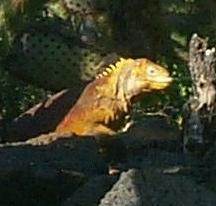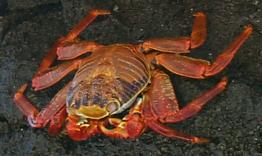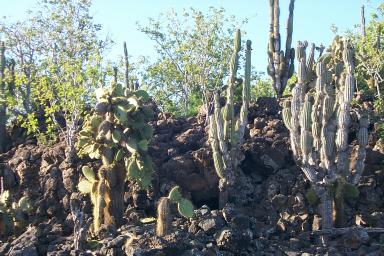

|
| Land iguana |
We went to the airport and checked through Guayaquil's small airport and security.
The plane was a 727-200, just an old airliner. Not the cargo plane we thought it might be. We got breakfast (again) on the plane. On arrival we went through Customs and stepped on some foam rubber with disinfectant. I think maybe that's more just to set the mood.
We got on a bus out to the dock to take a panga out to the boat. At the dock we saw frigate birds, diving boobies, and a brown pelican right next to the dock. Under the dock as we were getting on we noticed some sea lions lounging around in the shade.
While we were boarding the people from the previous week's trip were leaving. That will be us in a week!
We took our first panga (zodiac) ride to get out to the Polaris. They gave us snacks before calling us for lunch.
In the afternoon we went on panga rides in the Cerro Dragon area off the NW coast of Santa Cruz island. This area is also called Venicia because you can cruise around in a boat like you do the canals of Venice.

|
| Sally lightfoot crab |
While we were riding around we also saw a marine iguana (should see lots more tomorrow), a few sea lions lying on rocks, more brown pelicans (with "mating plumage" of a white head and neck and some yellow on the top of their heads), finches (Lucho could identify finches, but not the species), mockingbirds, yellow warblers (the only yellow bird on the island), more boobies (including a few that had stopped on land so we could see their blue feet) and frigate birds. Lucho could call to the warblers (a pretty good imitation) and they would come (he said his booby call, though, is "Here booby").
In the water we saw a spotted eagle ray, white tip sharks, a green sea turtle swimming underwater right next to the boat, and puffer fish (deflated).
The islands were all surrounded by mangroves (red, white, and black species in increasing order of height). In the mangroves we saw a striated heron. I was surprised that the red mangrove stems didn't root in the ground beneath the water but hang from branches and then branch off near the water line.
Also saw red sally lightfoot crabs (bigger than I thought) crawling on the rocks of the shore.

|
| Candelabra and prickly pear cactus |